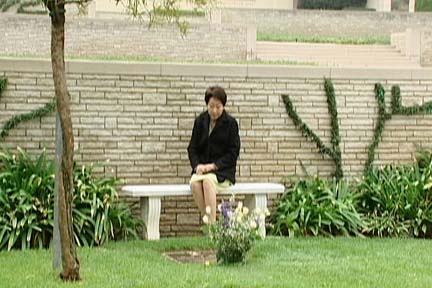
VISUAL COMMUNICATIONS
Jung Hui Lee at her son's gravesite
L.A. tale’s sequel
displays tension
While Southern California residents have been battling deadly wilderness wildfires, it was only 11 years ago that Los Angeles suffered inner-city "wildfires" when violence, arson and looting was sparked by the acquittal of four L.A. police officers in the beating of Rodney King, which was caught on home video and shown on television.
During the riots of 1992, Korean-American shop owners, in particular, suffered more than half of the total property damage, estimated at roughly $1 billion. New York-based documentarian Dai Sil Kim-Gibson was moved, three months after the upheaval, to travel to L.A. to capture on videotape the response of Korean-American women who were specifically victimized by the riots.
'Wet Sand:
Screens with "Saigon, USA"
Voices from L.A.
Ten Years Later'Screens: 6 p.m. tomorrow at the Doris Duke Theatre, Honolulu Academy of Arts
"Sa-I-Gu" (translated as "April 29," the first day of the riots) was the result, and since its national broadcast on PBS in 1993, it's been used by colleges and community organizations around the country to prompt discussions on race relations and the immigrant experience.
The same kind of lively discussion occurred Sept. 23 at the Japanese American Cultural & Community Center in L.A. after the premiere of Kim-Gibson's follow-up documentary, "Wet Sand: Voices from L.A. Ten Years Later." The reactions from the diverse audience was a still-unresolved mixture of sorrow, anger and injustice-fed frustration, but with the hopes that dialogue could be sparked to prevent future tragedy.
Kim-Gibson said that with "Wet Sand," "I decided to expand my interview pool to include people from other communities than Korean -- African, Latino and white." But the one story that threads through the documentary is that of Mrs. Jung Hui Lee. She and her husband lost their only son during the riots. A religious woman, she also regularly visits his grave site to keep his memory alive.
The Lees also represent the dwindling group of Korean immigrants who stayed on after the riots. "Lots of people I know have been struggling ever since the riots, until now," Kim-Gibson said. "They have no voice to speak up. A lot of people moved out of California or from the United States."
Kim-Gibson took it upon herself to revisit those affected by the riots, and she's made a sometimes moving, and ultimately cautionary, film about a simmering racial/economic situation in Los Angeles that could flare up again at any given time.
"As a Korean American, it upsets me profoundly that many new immigrants, with little knowledge of American history, strive to be 'white' for power and success, often adopting the white racism against African Americans," she said.
With a number of Korean-owned shops operating in neighborhoods that are predominantly black, one of the riot's many tragedies was the shooting death of a young black woman by a Korean shop owner. When the shop owner was later acquitted of the shooting, African Americans tried to boycott Korean-owned businesses.
"Things didn't get better afterward," Kim-Gibson said. "The racism went back underground. Compared to the truer diversity in Hawaii, there's still a 'black-and-white' distinction here that is still very predominant in the way people think.
"I want minority communities and oppressed people to become more aware of what and who are the real enemies: the social, economic structure and the mainstream people, many of whom are white Americans.
"What makes me sad is the continuing conflicts among minorities. (What happened in 1992) was neither an isolated event, nor was it caused by the African Americans, Latinos and Koreans, but was a succession of events caused by the deeply rooted flaws of American society. ... The dominant society is withdrawing more and more into its own havens for security, safety and power, continuing to charge the minorities and poor for the ills of society. And the minorities are pitted against each other, often causing volatile interactions among new immigrants and African Americans," she said.
Kim-Gibson attempted to create both "a moving, humane story with the Korean-American woman, intertwined with other interviews that would make it more issue-oriented than my first documentary," she said. "I also wanted to humanize these people, rather than making them statistics, issues and problems."
Even though, in her post-screening comments in L.A., Mrs. Lee chose to address her tragedy in personal, spiritual terms, Kim-Gibson said that it's an "anger wrapped in deep sorrow. She told me that she thought her son was killed by one person, but then she realized that it was something wrong in the society that led to this tragedy.
"Our hope is in communities coming together, struggling to prevent the fire next time and fighting for the unrealized hope, America."
Click for online
calendars and events.

